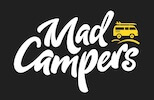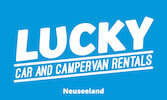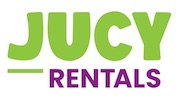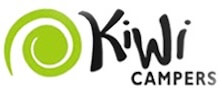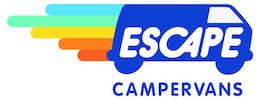Campervanning in New Zealand: Scenic Routes, Costs & Insider Tips

Snow-capped peaks, fern-filled forests, glow-worm caves and wild beaches—few places pack so much variety into such a compact territory as New Zealand. Thanks to a dense network of scenic roads and well-maintained campgrounds, the country has become a dream playground for travellers on four wheels.
Rolling up in a campervan or motorhome means your transport, bedroom and kitchen travel together; you can pivot plans when a hidden bay, a Māori cultural festival or a star-filled sky lures you to linger. The next sections break down why the road-trip style fits Aotearoa so well, how to rent the right vehicle, the best overnight options, and what budget to expect for a truly memorable adventure.
TABLE OF CONTENTS
- 1. Why Explore New Zealand in a Campervan?
- 2. Renting a Campervan or Motorhome in New Zealand
- 3. Self-containment & new legal standards
- 4. Top Campervan & Motorhome Road Trips in New Zealand
- 5. More Campervan Routes Across New Zealand
- 6. Where to Stay Overnight
- 6.1 Holiday Parks
- 6.2 DOC Campgrounds
- 6.3 Freedom Camping
- 6.4 Regional & Council Sites
- 6.5 NZMCA & Private Farm Stays
- 7. Budget & Costs for Your Adventure
- 7.1 Vehicle & Fuel
- 7.2 Camping Fees
- 7.3 Food & Drink
- 7.4 Activities & Attractions
- 7.5 Ferries, Tolls & Incidentals
- 7.6 Putting it Together
- 8. Driving a Campervan or Motorhome in New Zealand: Key Tips
- 9. Must-See Destinations for Campervan & Motorhome Travel
- 10. Best Time to Visit New Zealand in a Campervan
- 11. Practical Tips to Make the Most of Your Trip
- 12. Frequently Asked Questions (FAQs)
1. Why Explore New Zealand in a Campervan?
Imagine waking up beside Lake Pukaki with Mt Cook glowing pink at sunrise, brewing coffee in your kitchenette, then deciding on the spot whether to hike, kayak or simply keep gazing. That spontaneous freedom is the number-one reason travellers pick campervans here.
New Zealand’s compact geography means world-class scenery appears every few kilometres: drive only two hours and swap geothermal pools in Rotorua for Taupō’s volcanic lake, or cruise from Fiordland rainforests to Otago’s golden vineyards before lunch. With a “hotel on wheels” you skip check-in times, save on accommodation, and cook with local produce from roadside stalls—sweet Central Otago cherries in summer, kūmara fries on the Northland coast, or fresh mussels along the Marlborough Sounds.
Practicality seals the deal: over 420 freedom-camp spots (Wilderness NZ), 250+ DOC campgrounds and a nationwide grid of dump stations cater specifically to camper culture. Add Kiwi hospitality—friendly locals offering directions or the loan of a hose—and you have a laid-back, cost-efficient way to absorb NZ’s environment and culture at the same time.
2. Renting a Campervan or Motorhome in Switzerland
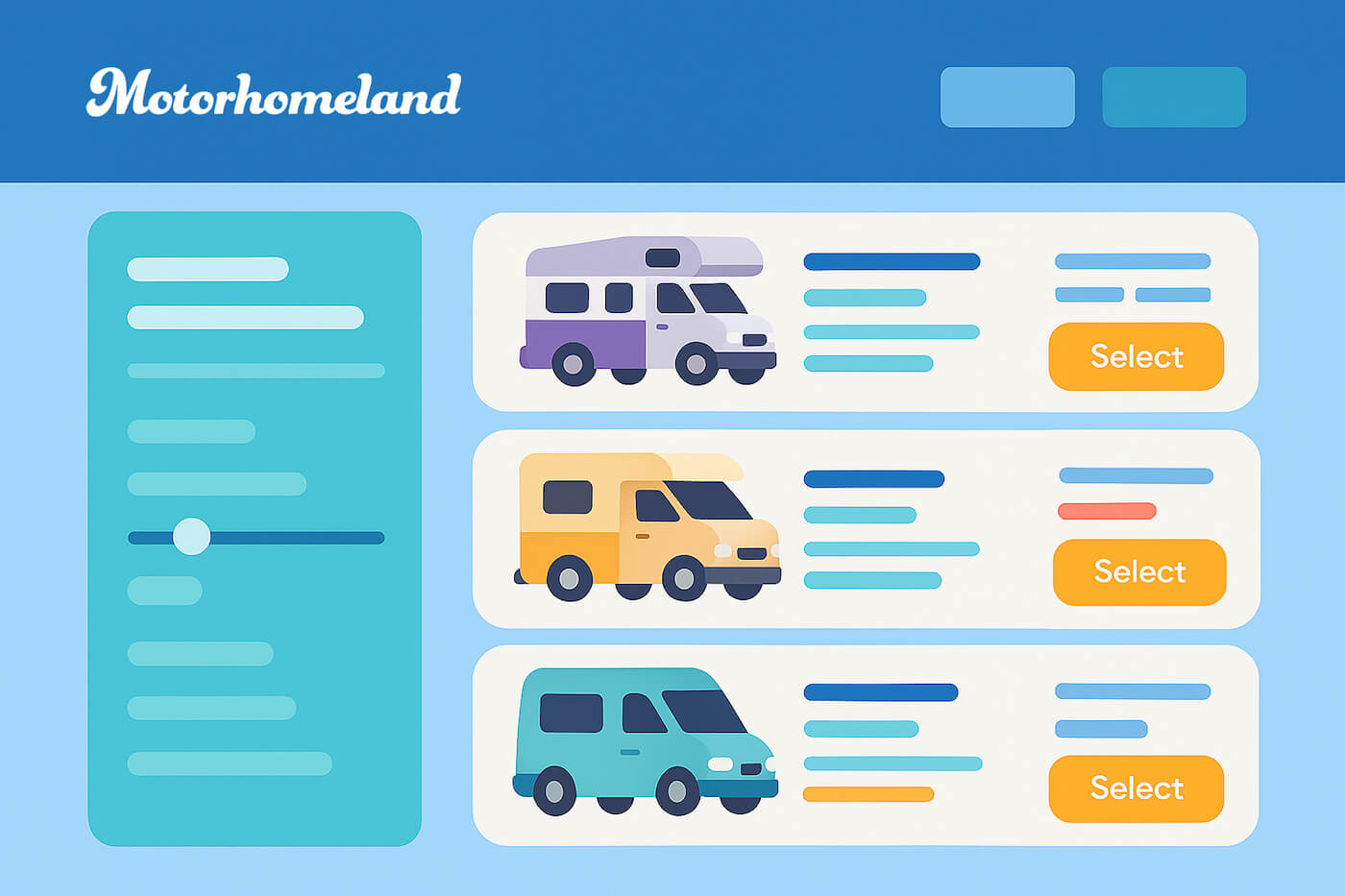
2.1 Current Rental Landscape
Demand for campervan travel exploded after 2020 and the choice has never been wider. You’ll find international brands alongside local outfits, plus peer-to-peer platforms for everything from vintage VW buses to expedition rigs. The biggest fleets cluster around Zurich and Geneva airports; competition is fiercest — and therefore prices lowest — in Geneva. Popular names you’ll come across include Indie Campers, Elitejoy, Blacksheep Campervans and Anywhere Campers. All Swiss-registered vehicles already wear the motorway vignette, and most include unlimited mileage — a real perk when you’re zig-zagging mountain roads.
2.2 Booking Through Our Comparator
Search live availability and final prices in one place: use the form below to compare multiple brands at once, with active promos applied automatically. Filter by city (Zurich/Geneva), dates, berths, transmission, weight class and onboard shower/WC, then refine to the exact layout you need.
For a clear overview of Swiss depots or current promotions, see our Switzerland campervan & motorhome hire guide.
2.3 Seasons, Rates and Money-Saving Tips
Rental costs swing sharply with the calendar. Broadly speaking,
- High season — July & August: a two-berth van in Geneva often runs CHF 120–140/day (peaks higher on prime dates).
- Mid-season — May, June & September: typically CHF 80–100/day; mountain passes open, crowds manageable.
- Low season — October to April: deals from ~CHF 65/day, ideal for Christmas markets or ski trips in a winterised motorhome.
Plan six months ahead for July–August, favour shoulder months for quieter sites, and note that domestic one-ways are modest while cross-border drops are pricey. Longer hires trigger tiered discounts — past two weeks, daily rates often fall by 10–15 % in our engine.
3. Self-containment & new legal standards
Since late 2023 only vehicles with a fixed, plumbed toilet can carry the blue self-contained certification (MBIE, 2023). Portable loos no longer qualify, meaning non-certified vans are barred from most freedom-camp spots and many council car parks. Before signing, confirm the sticker expiry date and keep the certificate handy for rangers.
To protect fragile environments, you must also empty grey- and black-water tanks at authorised dump stations—over 420 nationwide—and never discharge on the ground. Failing to comply risks a $200 on-the-spot fine plus possible insurance voiding. Stick to the rules and you’ll enjoy access to some of the planet’s most scenic free camps.
4. Top Campervan & Motorhome Road Trips in New Zealand
4.1 | 10-Day North Island Highlights

- Itinerary: Auckland > Coromandel > Rotorua > Taupō > Tongariro NP > Wellington
- Suggested Duration: 10 days
- Total Distance: ≈1,050 km
- Best Travel Season: Oct – Apr (warm, long days)
- Key Highlights: Cathedral Cove, Māori culture, geothermal pools, Tongariro Alpine Crossing, Te Papa Museum
From the urban buzz of Auckland to the creative capital of Wellington, this route strings together beaches, bubbling geysers and volcanic peaks. Daily drives are short, leaving plenty of time for hot-sand spas at Hot Water Beach, a cultural night in Rotorua or tackling one of the world’s finest day hikes, the Tongariro Alpine Crossing. Gourmet coffee, craft beer and free national-museum exhibits make Wellington a memorable finale.
Day 1-2 – Coromandel Peninsula
- Stock up in Auckland, then cruise SH25 past pohutukawa-lined bays to Hahei.
- Walk to Cathedral Cove; snorkel the marine reserve if seas are calm.
- Dig your own thermally-heated pool at Hot Water Beach two hours either side of low tide.
Day 3-4 – Rotorua
- Pause in Matamata for the Hobbiton™ Set tour before sulphur-scented Rotorua.
- Witness steaming Champagne Pool at Wai-O-Tapu; soak afterwards in the free Kuirau Park footbaths.
- Enjoy a hāngi feast and kapa haka at Te Puia.
Day 5 – Lake Taupō
- Marvel at the thundering turquoise torrent of Huka Falls.
- Kayak to Māori rock carvings or skydive 15,000 ft above NZ’s largest lake.
- Freedom camp (CSC only) at Hipapatua Reserve for sunset views.
Day 6-7 – Tongariro National Park
- Base yourself at Whakapapa Village; book a shuttle for the Alpine Crossing.
- Cross red craters and emerald lakes on the 19 km trek – weather can change fast.
- Non-hikers can ride the Sky Waka gondola for alpine panoramas.
Day 8 – Kapiti Coast Drive
- Break the 5-hour journey south in Ōtaki for outlet shopping and beach walks.
- Sample artisan cheese in Featherston or throw a gumboot in Taihape’s quirky park.
Day 9-10 – Wellington
- Park at Wellington TOP 10 and bus into town; entry to Te Papa is free.
- Ride the historic Cable Car, wander bohemian Cuba Street and sip a craft pint at Garage Project.
- Finish with a sunset drive up Mt Victoria before ferrying south or flying home.
4.2 | 14-Day South Island Grand Loop

- Itinerary: Christchurch > Lake Tekapo > Queenstown > Fiordland > Catlins > Dunedin > West Coast > Arthur’s Pass > Christchurch
- Suggested Duration: 14 days
- Total Distance: ≈2,100 km
- Best Travel Season: Nov – Mar for alpine roads free of snow
- Key Highlights: Dark-sky stargazing, Aoraki/Mt Cook, Milford Sound cruise, Catlins wildlife, glacier walks
This whistle-stop circuit delivers the South Island’s greatest hits: aquamarine lakes, fjords, glow-worm forests and two glaciers that plunge into rainforest. Expect jaw-dropping vistas every hour, from the mirror reflections of Lake Matheson to surf-lashed Nugget Point. Allow rest days; while distances look small, mountain passes and one-lane bridges keep speeds low.
Day 1-2 – Christchurch → Lake Tekapo & Aoraki/Mt Cook
- Follow SH8 across the Canterbury Plains to turquoise Lake Tekapo; photograph the Church of the Good Shepherd.
- Join a Dark Sky Project tour for Southern Cross stargazing.
- Next morning drive the shores of Lake Pukaki to White Horse Hill Campground and walk the Hooker Valley Track beneath NZ’s tallest peak.
Day 3-4 – Wānaka & Queenstown
- Cross the golden tussocks of Lindis Pass into Otago; pitch beside Lake Wānaka.
- Hike Roy’s Peak at dawn or relax at Rippon Vineyard.
- Take the scenic Crown Range Road to Queenstown; ride the Skyline gondola then feast on Fergburger.
Day 5-6 – Fiordland National Park
- Base in Te Anau; stock up—there’s no fuel in Milford.
- Drive SH94 through the Homer Tunnel; spot cheeky kea parrots en route.
- Cruise Milford Sound past Bowen & Stirling Falls; consider kayaking for seal encounters.
Day 7-8 – Southern Scenic Route & Catlins
- Roll south to windswept Curio Bay; watch Hector’s dolphins surfing the waves.
- Walk to Purakaunui Falls and lighthouse-topped Nugget Point at golden hour.
- Sample farm-gate cheese and craft beer in leafy Invercargill if you detour.
Day 9-10 – Dunedin → Arthur’s Pass
- Admire Victorian architecture and street art in Dunedin; tour Larnach Castle on Otago Peninsula.
- Drive SH1 north; stretch legs among the spherical Moeraki Boulders.
- Turn inland and ascend Arthur’s Pass; walk to Devil’s Punchbowl Falls before resting at DOC’s Klondyke Corner.
Day 11-12 – West Coast Glaciers
- Follow the Tasman Sea south to Hokitika for pounamu (greenstone) carving demos.
- At Franz Josef, stroll the valley floor to the glacier viewpoint or splurge on a heli-hike.
- Wake early at Lake Matheson for mirror reflections of Aoraki/Mt Cook and Mt Tasman.
Day 13-14 – Return to Christchurch
- Trace SH6 north to Greymouth, ducking into Punakaiki’s Pancake Rocks blowholes at high tide.
- Choose Lewis Pass for a change of scenery; soak sore muscles in alpine Hanmer Springs.
- Arrive in Christchurch, dump tanks at the holiday park and toast your 2,100-km odyssey in the regenerated riverside precinct.
4.3 | 7-Day Far North Explorer

- Itinerary: Auckland > Tutukaka Coast > Bay of Islands > Cape Reinga > Hokianga > Waipoua Forest > Auckland
- Suggested Duration: 7 days
- Total Distance: ≈800 km
- Best Travel Season: Nov – Apr (sub-tropical bliss)
- Key Highlights: Poor Knights diving, Waitangi Treaty Grounds, giant Cape Reinga dunes, 2,000-year-old kauri trees
Northland’s balmy climate, turquoise bays and deep Māori heritage make it ideal for a relaxed one-week road trip. Expect gold-sand beaches, legendary kauri forests and two-ocean views from NZ’s sacred northern tip. Seafood shacks and roadside fruit stalls keep taste-buds happy, while short driving legs mean more swim time.
Day 1 – Auckland → Tutukaka Coast
- Detour to Matakana’s Saturday farmers market for oysters and strawberries.
- Park beside Matapōuri Bay; tackle the short trail to Mermaid Pools if tides allow.
- Divers can book a day-trip to the Poor Knights Marine Reserve, rated by Cousteau among the world’s top ten dive sites.
Day 2 – Bay of Islands
- Base in Paihia; ferry to historic Russell, once the “Hell Hole of the Pacific”.
- Tour the Waitangi Treaty Grounds for insight into NZ’s founding document.
- Afternoon dolphin-spotting cruise to the famed Hole-in-the-Rock; overnight at beachfront Haruru Falls Holiday Park.
Day 3 – Cape Reinga & Ninety Mile Beach
- Rise early; fuel in Kaitaia before the final 100 km to the lighthouse where Tasman Sea meets Pacific Ocean.
- Slide down Te Paki’s giant dunes on a bodyboard (rentals on site).
- Freedom camp (CSC) at Tapotupotu Bay; watch the sun sink behind windswept headlands.
Day 4 – Hokianga Harbour
- Wind south to Ahipara; walk a slice of the endless shore but keep campers off the sand — rental contracts forbid beach driving.
- Cross to Omapere for harbour photo-ops and to hear tales of Opo the friendly dolphin.
- Sample freshly-caught snapper at a waterside pub before starry-night solitude.
Day 5-7 – Waipoua Forest & Return to Auckland
- Meet Tāne Mahuta, lord of the forest and the largest living kauri (51 m tall).
- Join a twilight guided walk to hear Māori legends and the haunting call of the morepork owl.
- Final swim at crystal-clear Kai Iwi Lakes, then cruise SH16 vineyard country back to the City of Sails, dropping your camper at dusk.
55. More Campervan Routes Across New Zealand

- Pacific Coast Highway – Auckland to Napier (790 km): Coromandel’s karst arches, Bay of Plenty surf breaks, East Cape’s untouched Maraehako Bay and Art-Deco Napier. Allow eight days to mesh beach mornings with pā site hikes. Stock fuel in Opotiki; stations thin until Gisborne.
- Forgotten World & Mt Taranaki Loop (680 km): From Taumarunui snake SH-43 through the Republic of Whangamōmona’s quirky pub, emerge under the perfect volcanic cone of Mount Taranaki, circle the Surf Highway and return via glow-worm-lit Tikitiki gorge. Five days.
- Southern Scenic Route (610 km): Dunedin ➜ Catlins ➜ Invercargill ➜ Te Anau. Rugged cliffs, petrified forest at Curio Bay, yellow-eyed penguins and oyster feasts in Bluff. Six days minimum; roads are sealed but remote – carry extra LPG.
- Alpine Lakes & Glaciers (Christchurch to Hokitika, 460 km): Cross Arthur’s Pass, photograph kea on Otira Viaduct, loop south to Franz Josef, then mirror-lake Matheson before finishing with greenstone carving lessons in Hokitika. Ideal four-day weekend.
- Twin-Coast Discovery (Auckland Loop, 850 km): Tackle Northland clockwise, comparing tranquil east-coast bays with wild Tasman sunsets. Add Waipoua Forest night-tour and Bay of Islands sailing for a leisurely nine-day escape.
- Kaikōura Coast & Marlborough Vineyards (540 km): Christchurch ➜ whale-watch Kaikōura ➜ seal-colony Ohau ➜ sip Sauvignon Blanc in Blenheim ➜ golden sands of Abel Tasman NP. Five days; book ferry if extending to Wellington.
6. Where to Stay Overnight
6.1 Holiday Parks

These privately run campgrounds are the plug-in, hot-shower, laundry-day solution. Expect powered sites, spotless shared kitchens, barbecue shelters, TV lounges and often playgrounds or hot pools. Prices average $20–$26 pp. Chains like Top 10 or Kiwi Holiday Park dot every tourist hub—Queenstown Lakeview, Tahuna Beach in Nelson, and the lakefront gem in Te Anau are perennial favourites. Book ahead for December–January and Easter; outside peak you can usually roll up late afternoon.
6.2 DOC Campgrounds

The Department of Conservation manages 250+ rustic sites woven into national parks. Facilities are basic—long-drop toilets, water from a tap or stream, maybe a shelter—but the settings are priceless: think beachside Totaranui (Abel Tasman), alpine White Horse Hill under Aoraki or forested Pelorus Bridge. Fees sit at $8–$15 pp; about 100 are totally free. Buy a seven-night DOC pass ($25 pp) if you’ll hop between multiple spots. Arrive by mid-afternoon in summer; first-come first-served.
6.3 Freedom Camping

Freedom camping—overnighting on public land outside formal sites—remains a cherished NZ privilege only for certified self-contained vehicles (MBIE rule). Councils publish bylaws and erect signs; the CamperMate app colour-codes legal areas. Classic free vistas include Lake Pukaki’s turquoise shore, Devil’s Gate on Lake Hāwea and Shotover Delta near Queenstown. Golden rules:
- Arrive late, leave early and keep noise down.
- No trace—pack out rubbish, use your onboard toilet, never dump waste.
- Respect stay limits (often 2 nights) and sensitive Māori sites.
Wardens fine $200 for breaches, so when in doubt ask the nearest i-SITE.
6.4 Regional & Council Sites
 Auckland, Wellington and other councils run scenic regional-park campgrounds (e.g., Wenderholm, Tāwharanui) bookable online, usually $16–$22 pp with basic amenities. They’re ideal buffers between city sightseeing days and wilder stretches. Some districts also offer low-cost “responsible camping” car parks with toilets and CCTV—check local websites on arrival.
Auckland, Wellington and other councils run scenic regional-park campgrounds (e.g., Wenderholm, Tāwharanui) bookable online, usually $16–$22 pp with basic amenities. They’re ideal buffers between city sightseeing days and wilder stretches. Some districts also offer low-cost “responsible camping” car parks with toilets and CCTV—check local websites on arrival.
6.5 NZMCA & Private Farm Stays

If you’re touring for several weeks, joining the NZ Motor Caravan Association unlocks 180+ members-only parks for ~$3–$5 per person. For something unique, apps like Campable link travellers with vineyards, orchards and sheep-stations offering secluded spots (typically $20–$40 per vehicle) plus farm-to-table experiences.
7. Budget & Costs for Your Adventure

7.1 Vehicle & Fuel
As shown earlier, rental fees dominate the budget: from $45/day in winter for a basic van to $750+ in midsummer for a six-berth. Fuel averages $2.70/L (petrol) and $2.10/L (diesel) in 2025 (GlobalPetrolPrices). A 2-week, 2,000 km loop in a mid-size diesel camper comes to roughly $500–$650 in fuel plus $160 in road-user charges.
7.2 Camping Fees
Mixing accommodation keeps costs sane. A common pattern—holiday park every third night, DOC or freedom spots the rest—lands near $25/night for two people. Opting for powered holiday-park sites every evening pushes that above $45–$50.
7.3 Food & Drink
Self-catering is the camper’s super-power. Supermarket staples cost: bread $3, 1 L milk $4, 500 g pasta $2, dozen eggs $7 (Fly Homes). Cooking breakfast and dinner plus picnic lunches runs about $20 pp daily. Allow extra for flat whites ($5 each) or iconic treats like Queenstown’s Fergburger ($15). Craft-beer lovers: a pint in a pub sits at $10–$12 (Numbeo).
7.4 Activities & Attractions
Nature is free, but bucket-list thrills add up. Milford Sound cruise $120, Hobbiton set $89, bungy jump $205, heli-hike $500+, Wai-O-Tapu geothermal park $40. Many travellers earmark $500–$1,000 pp for paid experiences across a fortnight.
7.5 Ferries, Tolls & Incidentals
Cook Strait crossing for two adults and a 6-m motorhome costs around $550 one-way; book early. North-Island toll roads (Auckland Pūhoi, Tauranga) are minimal—about $2–$2.60 each and payable online. Laundry runs $4 per wash, LPG bottle swap $35, coin showers at some DOC sites $2.
7.6 Putting it Together
For a 14-day shoulder-season trip, two people sharing a self-contained van might budget as follows:
| Category | Estimated total (NZ$) |
|---|---|
| Vehicle hire incl. zero-excess cover | 2,800 |
| Fuel & RUC | 650 |
| Camping fees (mixed) | 350 |
| Food & drink | 560 |
| Activities & entries | 700 |
| Ferry (one-way Southbound) | 550 |
| Miscellaneous | 140 |
| Total | 5,750 ≈ NZ$410/day |
Trim costs by travelling in May or September, booking relocation specials, prioritising free hikes over premium tours, and stocking up at Pak’nSave rather than small grocery stores. Splurge seekers can push the figure skyward with gourmet dining, scenic flights and luxury motorhomes—New Zealand caters for every style.
8. Driving a Campervan or Motorhome in New Zealand: Key Tips

-
Keep left at all times. New Zealand drives on the left-hand side of the road; nearly every rental places a “KEEP LEFT” sticker on the windscreen to remind visitors.
-
Speed limits – Cars and campervans under 3.5 t: 50 km/h in urban areas, 100 km/h on open roads. Motorhomes over 3.5 t: legal maximum 90 km/h even where the limit is 100 km/h. Police use hidden cameras; fines arrive via your rental company, so obey the signs.
-
Seat-belts are compulsory for every passenger, front and rear. Children under seven must travel in an approved child seat.
-
Alcohol limit: 0.05 % BAC for drivers 20 +. Under-20s have a zero limit. Random breath testing is common; exceed the limit and both your licence and insurance are in jeopardy.
-
Documentation: carry your passport, full driving licence and, if the licence is not in English, an official translation or International Driving Permit.
-
Road types & one-lane bridges. Outside the main centres most highways are two-lane, undivided and winding. Hundreds of bridges are single-lane; look for the big arrow on the sign – large arrow = you have right of way, small arrow = you give way.
-
Fuel & Road-User Charges (RUC). Petrol averages NZ $2.70 / L; diesel ≈ NZ $2.10 / L but attracts an extra ~NZ 7–8 ¢ per km in RUC, usually settled when you return the van.
-
Few toll roads – only three short stretches near Auckland and Tauranga. No booths: pay online within five days at tollroad.govt.nz or at selected petrol stations to avoid admin fees.
-
Snow, ice and high winds. Between June and September alpine passes such as Arthur’s, Lindis and the Milford Road can require chains (supplied with most winter rentals). Check live conditions at NZTA Journey Planner before you depart.
-
Common hazards: tight hairpins, narrow shoulders, wandering stock and the occasional mischievous kea parrot on the West Coast. Reduce speed and avoid sudden swerves.
-
Fuel and services in remote areas. Between Haast and Fox Glacier, or north of Kaitaia, petrol stations can be 100 km apart. Re-fill when the tank is half-full and stock drinking water regularly – most township taps supply potable water.
-
Dump-stations are mandatory for waste. Use the blue-signed dump points shown in the free CamperMate or Rankers apps; never empty tanks into public toilets or storm drains.
-
Freedom-camp only in permitted spots and only if your vehicle displays the blue Certified Self-Contained sticker (fixed toilet required under the 2023 law update). Fines for illegal camping start at NZ $200.
-
Let faster traffic pass. If five or more vehicles queue behind you, pull into the next slow-vehicle bay – it’s polite and prevents dangerous overtaking.
-
Night driving is not recommended on rural roads: they are unlit, you’ll miss the scenery, and stock or wildlife may be on the carriageway.
9. Must-See Destinations for Campervan & Motorhome Travel

- Milford Sound, Fiordland: Sheer granite faces plunge into ink-black water; rain only amplifies hundreds of ephemeral waterfalls. Limited parking – overnight 120 km away in Te Anau, then drive at dawn for tranquillity.
- Abel Tasman National Park: Golden beaches, emerald estuaries and coastal tracks accessible by water-taxi. Beach-side DOC camps (Anchorage, Totaranui) mean coffee-with-a-view each sunrise.
- Mount Cook National Park: Hooker and Tasman glaciers, icebergs and alpine flowers under NZ’s tallest peak. White Horse Hill campground’s $15 view beats any five-star hotel.
- Rotorua Geothermal Zone: Neon-green Champagne Pool at Wai-O-Tapu, burping mud pots and soothing hot-stream baths – all minutes from full-service holiday parks.
- Bay of Islands: 144 subtropical islets for sailing, snorkelling and dolphin spotting plus the historic Waitangi Treaty Grounds. Numerous campgrounds allow easy island-hopping.
- Franz Josef & Fox Glaciers: One of the few places worldwide where rivers of ice snake through rainforest. Valley walks are free; splurge on a heli-hike for bucket-list memories.
- Tongariro National Park: Volcanic moonscapes featured as Mordor in LOTR; the Alpine Crossing ranks among the planet’s top day-hikes. Several DOC camps straddle trailheads.
10. Best Time to Visit New Zealand in a Campervan
New Zealand rewards road-trippers all year, yet weather, daylight and crowd levels change quickly as the seasons rotate across 14 degrees of latitude.
February – mid-April (Optimal)
Midsummer warmth lingers, the holiday crowds retreat after Waitangi Day, and campgrounds feel relaxed. Days remain long enough for alpine hikes and coastal swims, grape harvests fill cellar doors with energy, and rental prices slide from their December peak. Nights cool slightly – perfect sleeping temperatures – yet snow is still weeks away. Drawback: popular DOC sites still fill by late afternoon near Aoraki/Mt Cook or Abel Tasman, so arrive early.
Late October – November (Spring alternative)
Wildflowers blanket Central Otago, waterfalls roar with snow-melt and newborn lambs dot every hillside. You’ll enjoy shoulder-season rates and half-empty holiday parks. Temperatures rise into the high teens, but rapid southerly fronts can dump rain or even late snow on alpine passes – flexibility is essential. Sandflies are minimal until December.
June – August (Winter value)
Ski bunnies score cheap van hires and near-empty DOC camps. Frosty dawns give way to crystal-clear midday light, and geothermal pools in Rotorua feel even better at 5 °C air temperature. Major drawbacks: short daylight (only ≈ 9 h in July), chain controls on the Milford Road, and some remote campsites closed for maintenance.
December – mid-January (Summer peak)
School holidays turn every beach and lakefront into a playground. Sunshine extends past 9 pm, cherry stalls pop up on road verges and all Great Walk huts are open. Expect the year’s highest rental rates and book campsites weeks ahead. Sandflies thrive on Fiordland evenings; pack repellent.
11. Practical Tips to Make the Most of Your Trip

- Download CamperMate before landing (apple, android); it works offline and pinpoints free camps, dump stations and even cheap firewood suppliers.
- Buy groceries at Pak’nSave or Countdown in large towns and stash dry goods; village stores can be 30 % dearer.
- Carry coins for rural laundries. Many holiday-park machines still run on NZ $2 pieces and reception may close at 8 pm.
- Use the free public hot showers at Tekapo’s lakeside toilets – a rare luxury outside paid parks.
- Insect-proof your doors with cheap magnetic mesh bought in K-mart; sandflies cannot squeeze through but air can.
- Refuel at half-tank on the West Coast; stations between Haast and Franz Josef sometimes close at dusk for safety training.
- Carry a 10-metre mains lead plus adapter; older DOC campgrounds often hide their single power post behind trees.
- Visit an i-SITE on arrival in any region; staff happily print local freedom-camp maps and weather warnings for mountain roads.
- Stow valuables in the supplied safe when taking long hikes – vehicle break-ins are rare but usually target cameras left visible.
- Book your Cook Strait ferry before booking domestic flights; crossing times decide your whole timetable, and vehicle spaces sell out first.
12. Frequently Asked Questions (FAQs)
1. Do I really need to pre-book campgrounds in summer?
If you plan to stay in holiday parks near hotspots such as Queenstown, Rotorua or Paihia between 20 December and 31 January, yes – book at least a week ahead. DOC and freedom sites cannot be reserved, so reach them by mid-afternoon to secure a bay.
2. Is driving a 7-metre motorhome difficult on NZ roads?
The highways are paved and sign-posted but noticeably narrower than North-American or European dual carriageways. Take corners slowly, pull over for faster traffic and avoid city rush hours. After a day you’ll adapt – thousands of visitors manage each year.
3. Can I park a campervan overnight on a residential street?
Most councils forbid this unless signage explicitly allows self-contained vehicles. In cities, use designated “camping permitted” car parks or nearby holiday parks to avoid a NZ $200 fine and an early-morning knock from compliance officers.
4. How much does diesel Road-User Charge add to my budget?
Current RUC for typical campervans is roughly 8 ¢ per km. A 2,000 km loop therefore adds about NZ $160, often invoiced when you return the vehicle. Petrol vehicles avoid RUC but pay higher pump prices.
5. Will my phone work everywhere?
Coverage is excellent along main highways and towns. Expect dead zones in Fiordland, the East Cape and parts of the West Coast. Download offline maps and tell someone your route when heading into black-spots.
6. Are snow chains mandatory in winter?
Chains must be carried on alpine highways when the electronic signs instruct. Rental depots will demonstrate fitting; practise once in the yard so you’re not learning in a blizzard on Lindis Pass.
7. Can I bring my pet in a rental motorhome?
Only a handful of companies – e.g., Kiwi Motorhomes – accept animals, generally after paying an extra cleaning bond. Always confirm in writing before arrival.
8. Is the water in DOC camps safe to drink?
Many DOC taps are untreated stream supply; signs will say “boil before drinking”. Carry a 10 L jerry can of known potable water or boil for three minutes when in doubt.
9. What happens if I get a speeding ticket from a camera?
The notice is mailed to the rental company, which will charge the fine to your credit card plus an admin fee (often NZ $30). Check your email for the official infringement details.
10. Do I need coins for toll roads?
No. New Zealand’s tolls are barrier-free. Pay online with your licence-plate number within five days at tollroad.govt.nz, or the agency will invoice the rental firm and they’ll add a processing fee.
11. Is wild camping allowed in national parks?
Sleeping in a vehicle outside designated areas inside a national park boundary is illegal. Use the official DOC sites; many cost only NZ $10 per adult and keep the wilderness pristine.
12. How far in advance should I book a campervan for February?
Premium and mid-range fleets can be 90 % booked six months out. Reserve by August if you want a specific layout or intend to start in Queenstown, where vehicle supply is limited.

